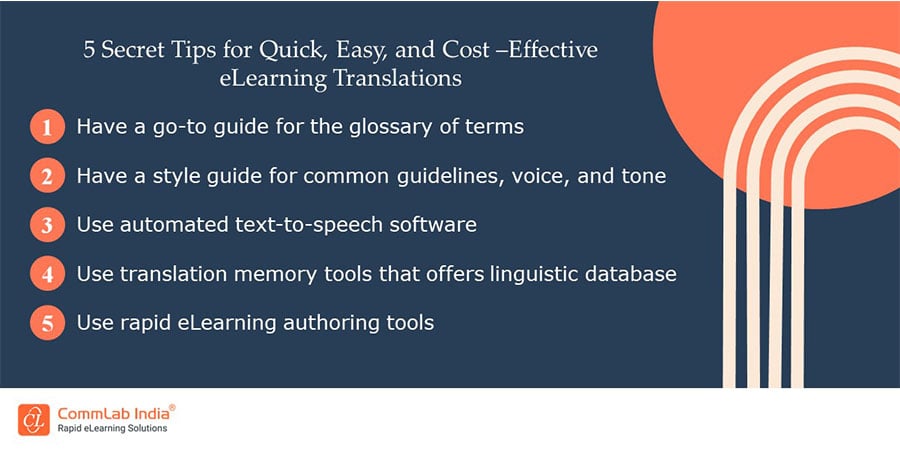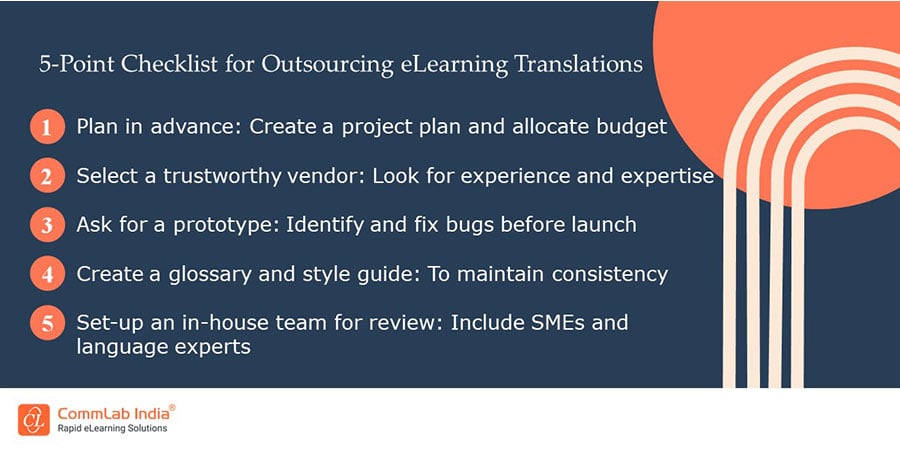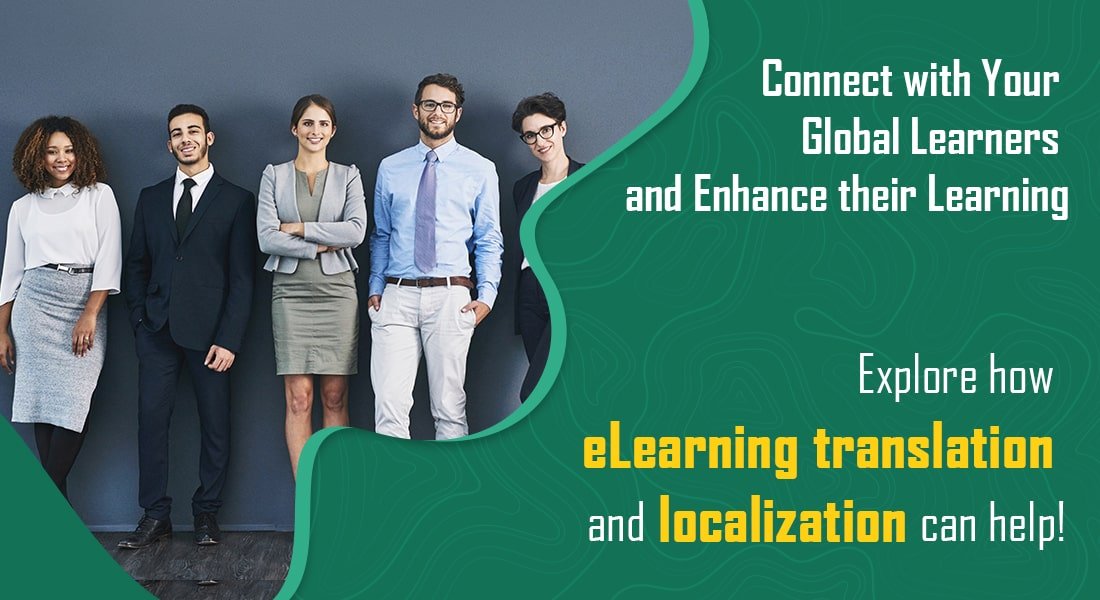eLearning Translations — Should We Outsource or Do it In-House?

Hallo! Hola! Bonjour! Basically Hello. Doesn’t it add an extra inch to your smile whenever you are addressed in your native language? This aspect plays a crucial part when it comes to learning as well. With most organizations going global, having a diverse workforce is certain; be it in language or cultural sensibilities. With learning and development becoming an indispensable part of businesses, how do you ensure to train your diverse workforce uniformly with equal fervor? Well, eLearning translations are here to your rescue!
With eLearning translations, you can cater to the training needs of your globally dispersed diverse employees and bridge the cultural and linguistic gaps. Having said that, the next big question that must be popping into your head is, are eLearning translations necessary when most of your employees understand English? Well, knowing a language and getting the subtle nuances of it are quite different. Most learners prefer learning in their native language as it becomes easy to learn and retain the subject. So, it is preferably a wonderful idea to offer training to your global employees in their native language.
Doing In-House eLearning Translations Can Be a Daunting Task!
Here are the common pitfalls you might face:
- Lack of Language and Domain Expertise
- Lack of Technical Competence
- Lack of Quality, Employee Productivity, and Breach of Set Timelines
Now that you are aware that eLearning translations are inevitable to effective corporate training for global learners, you must be wondering how to go about it. And here comes the question as old as time — Should you outsource or do it in-house? Well, let’s explore!
In-house eLearning Translations — Is it Feasible?
If you have been designing and developing eLearning courses in-house, you must be thinking why not proceed with eLearning translations too? Well, the idea might seem appealing at first glance, and for good reasons. While there are a few benefits like no immediate costs or better information security, there are certain drawbacks to it, and you might not find it lucrative in the long run. Let’s see what can go wrong if you choose to use your in-house team for eLearning translations:
1. Lack of Language and Domain Expertise
Knowing a language and having a mastery of it are two different things. It might appear so, but it is not that simple. A good translator must have sound technical skills. An expert eLearning translator needs to be good at grammar, have a rich vocabulary, able to understand cultural sensitivities, and should understand idioms and catchphrases. The whole idea is to translate the content into a different language while keeping its essence intact.
Not only this, but your in-house translator must also have a basic knowledge of eLearning design and development and must understand that the translated content is meant to be a part of a course for corporate training. They should also have a fair amount of domain knowledge to maintain the technical accuracy of various terminologies and ensure the meaning and the impact of the content are not diluted in the due course of translation.
→ Download eBook: eLearning Translations — 7 FAQs Answered!
2. Lack of Technical Competence
eLearning translations are not just about translating the content. There are a lot of technical aspects involved in the process. Your in-house team must be good at the language but might not have the necessary technical competence when it comes to the usage of various tools for quick and seamless translation of eLearning courses.
Computer assisted translation tools (CAT tools) make the eLearning translation process fast and accurate. Rapid authoring tools like Adobe Captivate, Articulate Storyline, and Lectora Inspire facilitate hassle-free eLearning translations. Your in-house team might not have the required expertise in using these tools. If you are planning to train your team on this, I am afraid, but it will be a costly and time-consuming affair and outsourcing would be a feasible alternative.
Watch this video to stay away from common pitfalls in eLearning translations.
3. Lack of Quality, Employee Productivity, and Breach of Set Timelines
You might feel it’s a great idea to use your employees’ multilingual skills, but the translated courses might lack the quality and essence of a good eLearning course. This could be due to various reasons, a few are:
- Lack of experience and expertise of your in-house team in doing the said task. Your team might not have prior experience with such projects and hence they might not be able to ensure the quality of the translated courses.
- Due to involvement in multiple projects, they might not be able to balance their primary responsibilities which might hamper productivity and their overall performance. This might take a toll on your overall business ROI.
- Since they would be taking the eLearning translation task as their second priority, they might not be able to devote the needed time for the timely completion of the project and your course rollouts might get delayed.
In case you want to give it a try and do it in-house, here are a few secret tips to help you crack the code.

Outsourcing eLearning Translations —Why is it the Better Bet?
Now that you know the challenges that you might face with in-house eLearning translations, what about giving thought to outsourcing it?
Professional eLearning translation partners can help you in many ways:
- Good quality eLearning translations to engage your global learners and enhance the quality of training.
- Timely rollout of courses as they bring in their domain experience and expertise.
- Reduced cost of training your in-house team on the nuances of eLearning translations and authoring tools.
- Relieve your in-house team from the additional burden and free them for greater business priorities.

Parting Thoughts!
eLearning is slowly gaining momentum in recent times as it fulfills the evolving training needs of modern corporate setups. It has certainly paved the path of uninterrupted training for the hybrid and remote workforce. And eLearning translations are the icing on the cake. It has facilitated organizations to cater to their global learners seamlessly. Hope this blog has helped you understand its importance for ensuring effective training for your learners and weigh the pros and cons of doing it in-house or outsourcing it. Trust me, in the long run, it’ll be a smarter move to outsource. So, think twice before you plan to involve your in-house team in eLearning translations.
Have more questions? Well, check this eBook for answers. Download it now!




![5 Key Features of AI-Based eLearning Translations [Infographic]](https://blog.commlabindia.com/hubfs/blogs/key-features-ai-based-elearning-translations-inf.jpg)
![5 Secrets to Quick, Easy and Cost-effective eLearning Translations [Infographic]](https://blog.commlabindia.com/hubfs/Imported_Blog_Media/elearning-translations-quick-ways-info.jpg)